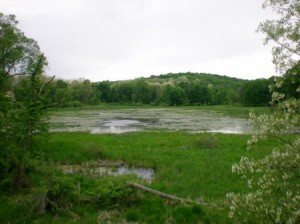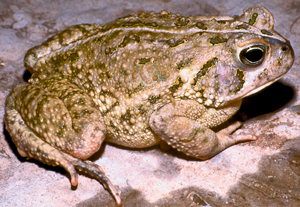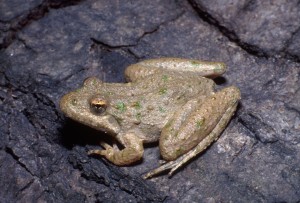LANSING–In 2006, Edythe Sonntag took off in her car in search of an amphibian no bigger than her thumbnail.
The Michigan State University doctoral student racked up 14,000 miles on her vehicle that summer, but Sonntag also got a better idea of how Blanchard’s cricket frog populations have declined over time. She used the Michigan Frog and Toad Survey to help.
The survey, along with other reports about historical populations, allowed Sonntag to visit each site where the frog had been documented.

From mid-May to mid-July, surveyors can identify the cricket frog in muddy, semi-open habitat by its breeding call which sounds like two pebbles tapped together. Photo: Jim Harding
Next month marks the 15th year that Michigan conservation officials will help residents conduct population surveys of the state’s 13 frog and toad species. All eight Great Lakes states have some form of frog and toad survey each year. The first survey was developed and implemented in 1981 by Ruth Hine and Mike Mossman of the Wisconsin Department of Natural Resources.
Michigan’s survey began in 1996 with department biologist Ray Rustem. Scientific reports have documented amphibian declines in the United States since the 1980s. No universal factor has been identified for the declines, but scientists suspect they may be due to habitat destruction or alteration, chemical pollution, amphibian diseases, climate change and others. Rustem started a volunteer program to monitor Michigan’s populations.
One to 50 volunteers are assigned to one of more than 400 routes across the state each spring. Starting in April, volunteers–school classes, biologists and members of the public–visit their assigned areas three times throughout the frogs’ breeding season. Species are identified by their distinct breeding calls between March and June. Volunteers train with a CD of the calls before taking a route.
Numbers appear stable
Last year’s results show stable numbers, according to Lori Sargent, survey coordinator and endangered species specialist.
“Most of the common ones are staying common and the rare ones are staying rare,” she said.

Fowlers toad. Photo: Jim Harding
But volunteers heard no Fowler’s toad calls last year. Sargent said they are typically common, but she’s not worried. The survey is primarily used to indicate geographic locations where the department may not have a route or sites in the state where additional surveying should be completed to gain more information about species found there.
That is the case for Fowler’s toad, Sargent said. Because volunteers visit areas where frogs already have been heard, Sargent said other populations may exist in areas that aren’t highlighted by volunteer routes.
The survey is also used to identify future research projects on specific species and situations. Most of the other Great Lakes frog and toad surveys are operated by state environmental or natural resources departments, though Illinois and Pennsylvania do not have statewide surveys and instead have environmental groups that do local forms of surveys.
States often report their results to herpetology atlas projects that collect data on amphibians and reptiles for the state or to the U.S. Geological Survey’s North American Amphibian Monitoring Program. The program attempted to standardize the protocol for
View Great Lakes Frog and Toad Calling Surveys in a larger map
frog and toad surveys among participating states and achieved that goal in 2001. Twenty-two states reported information from 1600 surveys last year. This spring will mark the 10th year the program has received data, allowing them to conduct a 10-year analysis of population trends. Michigan is not a part of the group because it began surveying with a different procedure before the program was developed, Sargent said.
Fowler’s toad targeted
Sargent plans to suggest more specific research plans for Fowler’s toad this spring, in addition to new survey projects for all native amphibians to study those that are harder to find and cover areas for which they have less data.
But Jim Harding is worried about species like the Fowler’s toad. “If any species is going to start disappearing because it gets a little bit dry or a little bit rough, that’ll be Fowler’s toad,” said the wildlife information specialist of Michigan State University’s Museum and department of zoology.
Harding said Fowler’s toad is common in other states to the east and south. In Michigan, it has decreased its range to the southern and western parts of the Lower Peninsula near Lake Michigan. The lake makes weather milder and creates more snow, providing greater insulation for the toads in winter.
As specialists–those animals that require specific resources or environmental conditions to survive–species like Fowler’s toad may succumb to pressure first, Harding said.
Small frogs, big problems

Declines in Great Lakes cricket frogs are thought to be a result of habitat destruction, pollution and competition from other frogs. Photo: Jim Harding
Sonntag is trying to prevent such an event for the cricket frog, which she believes should maintain a place within its native habitat. After more than three years of study, she has an obvious affection for them.
“They’re small and they’re squishy so they’re like the M&M’s of nature,” she said.
Despite their small size, Sonntag has made a big deal over their decline. Further surveys she conducted since 2006 have identified current populations as well as possible contributors to habitat loss and population decline.
One successful project rescued an established population from a condominium development site in Ypsilanti, Mich. State officials transferred the frogs to a remediated gravel pit near Port Huron on the St. Clair River. The population has lived there for five years.
Harding and Sonntag said the survey creates public awareness about amphibian populations and can indicate potential environmental hazards–amphibians are good indicators of water and environmental quality.
They also think habitat loss and land development are probably behind declines in Michigan, but Harding said since baseline data is absent for these populations, they may never know the true state of Michigan’s frogs and toads or the natural fluctuations that occur in their populations.
But the survey may lead to discovery of new populations. Sonntag said there are other populations of cricket frogs in Michigan–she’s found several without historical department records before.
“It’s just nobody’s been listening,” Sonntag said.